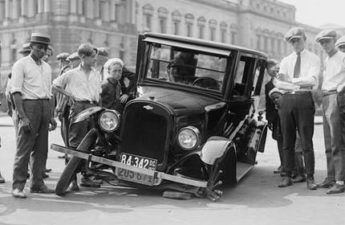Everyone wants to avoid making major strategic mistakes.
The problem is that the world is complex and most decision-making models and strategies are based on simple tools and processes.
It is difficult to foresee and plan for all the factors that might impact a positive outcome.
Therefore, you need to find the weak points in your strategies before the strategy is implemented.
This can only be accomplished by applying a rigorous process to your strategic decision making and following it ruthlessly.
Seeing where a strategy can go wrong ahead of time means you can take actions to prevent those bad outcomes from occurring. In the heat of the moment, strategic planning that’s inaccurate, incomplete, or simply wrong forces people to revert to on-the-spot decision making.
That’s sometimes necessary. But making it up as you go is more often than not associated with failure. It is usually reflective of ineffective or inaccurate anticipation of competitive moves, environmental changes, or just plain poor prior perception and thinking.
Anticipating problems ahead-of-time allows one to change course when necessary.
Here are some ways to better develop strategies and avoid on-the-fly decision making.
Have the strategy developed by diverse strategic groups
Using groups organized around strategic initiatives allows for better focus. Those should be staffed by people who can analyze problems from various functional perspectives.
These types of strategic initiative groups can develop alternate decisions and actions on key business issues.
For example, an alternate use for products and or technologies may be developed that would not be obvious to those closest to the problem/technology/product.
Develop Situational Awareness
Situational awareness is when you have assessed a situation or environment from various vantage points and have considered all potential perspectives. This idea is common in the military, martial arts, and sports world. For example, a great quarterback can “see” the whole field whereas lesser players cannot.
In the real business world, things are much less clear. There are no player formations, landscapes, or troop movements to see.
That’s when it is even more important to “see” and understand the environments in which we operate and foresee how different hard to discern factors affect our decisions.
There are many ways to build situational awareness. One is to talk through alternate realities. This may sound out there, but alternative realities are basically hypotheticals. Einstein used to call these, “Thought Experiments.”
Event A may happen, but what if B or C happens? What if the order of events is different or the competition reacts in a different way than anticipated?
Do a Thought Experiment and think about the likely outcome in each of those situations. To develop better situational awareness, start by forming teams and tasking them to develop alternatives based on different views of the same situation.
Examples of this could be discussing the consequences of new competitors. What if a competitor enters the market sooner the expected? Later? Could they surprise and outmaneuver us? What are our competitors’ motivations? Could they act in unusual, extreme or desperate ways?
Next, consider these hypothetical situations altogether – collectively. Determine what countermeasures will have the most impact. What can we do to blunt these outside threats?
A really important task is to identify what signals indicate that any of these alternative scenarios are unfolding. Discussing these signals ahead of time beforehand is important. Good awareness of these signals can allow you to define when to change your actions or direction.
After you’ve identified these signals, track them regularly in a way that all senior management can easily understand. Having these signals understood upfront and tracking them reduces counter-productive debate when course changes are necessary. Sometimes organizations need to move quickly and delays caused by internal debate can be quite harmful.
A situational awareness review should be conducted periodically to update and discuss the prior identified alternative scenarios. The world does change and new threats may emerge.
This does require work and time. These smallish amounts of time can result in positive results worth well beyond the time expended.
You may gain new insights about your organization’s readiness and the wisdom of management. Those insights may have gone unnoticed until an actual emergency occurs.
Gaming
Another technique is gaming a situation.
There really is no substitute for putting real people into a simulated situation to see how they react together.
Some organizations are now using AI simulations for this. While AI simulation can be useful it lacks the variability and ingenuity of human creativity.
Here’s an example. Militaries across the world prepare for hostile situations using war games. These usually involve live simulated battles to improve operational capabilities. (They also can serve as propaganda tools in some circumstances, but that is beyond the subject of this article). There is nothing like actually being in a war-like situation out in the field.
War-gaming exercises around critical decisions can also be used for business decision-making.
A good way to do this is to assign high-performing managers to lead “opposing” teams, which should be made up of individuals with expertise across relevant functional areas. Before the exercise, make sure everyone understands the general challenge and provides specific information and data about the challenge/situation.
A good practice is to assign the line managers responsible for the situation in your organization to lead the overall exercise. Then each group in the game will present what they found to everyone else at the end of the exercise.
Providing incentives to all who participate will result in those taking part to have more motivation to do their best. This could be having a senior manager judging the results or providing cash incentives. Often just rewarding the “winners” through recognition is enough.
Have an outside-in perspective
This technique can highlight under-leveraged capabilities or untapped sources of competitive advantage.
Basically, this is getting a perspective from a person, group, or organization that works with your business and sees it from a different angle than does those from the inside.
Sometimes the input from these outsiders has a dramatic and positive impact on an organization. Capabilities and company strengths can be redirected and utilized in different ways than expected or previously considered.
These missed opportunities can be from assets or capabilities that are often considered to be a “cost of doing business” and therefore dismissed as being useful in a wider context.
These could include a global supply chain, unique abilities to quality test products, proprietary communication channels with customers and other key constituents, unique manufacturing capabilities, etc. The list is endless and depends on what the business has to offer.
To be considered for example: In the future under any of the hypothetical scenarios, could anything we are overlooking become new lines of business or cost reduction opportunities? If your environment changes unexpectedly could any of these assets help you to adapt?
In companies, an outside-in perspective can help shape an honest view of your organization’s strengths (and weaknesses). Customers can be a great source for this. Forming a strategic advisory council is another option.
There are many other ways to improve strategic planning can improve your strategies. The most important point is that strategic planning processes should increase your organizations’ flexibility and resourcefulness, not reduce it.



